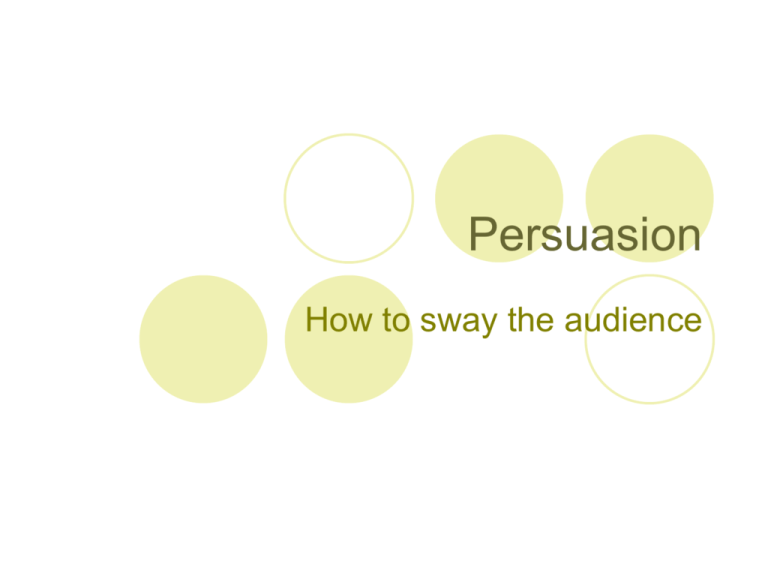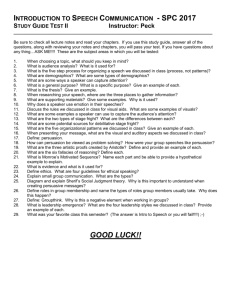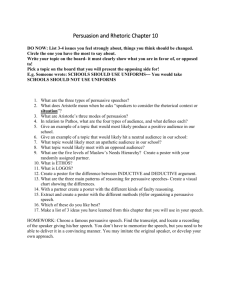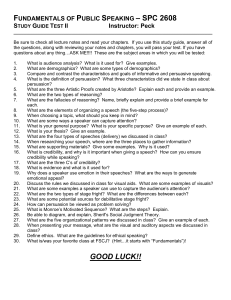Persuasion
advertisement

Persuasion How to sway the audience The Importance of Persuasion Persuasion is the process of creating, reinforcing, or changing people’s beliefs or actions. The ability to speak and write persuasively will benefit you in every part of your life! Understanding the principles of persuasion is also vital to being an informed citizen and consumer. Something to Note… When you speak to persuade, you act as an advocate. Your job is to get others to believe with you and possibly act on that belief. Your goal may be to defend an idea, to refute an opponent, to sell a program, or to inspire people to action. Ethics in Persuasion Make sure your goals are ethically sound and that you can defend them if they are questioned or challenged. Study your topic so that you do not mislead your audience through muddled thinking. Be honest in what you say. There is no place in ethical thinking for false or deceptive statements. The Psychology of Persuasion Persuasion is a psychological process. It occurs in a situation where two or more points of view exist. There must be a disagreement, or there would be no need for persuasion. The Psychology of Persuasion: The Challenge of Persuasive Speaking Of all types of public speaking, persuasion is the most complex and the most challenging. In every persuasive speech, you will face some listeners who are strongly in favor of your position, some who are neutral, and some who are adamantly opposed. How successful you are in any particular persuasive speech will depend above all on how well you tailor your message to the values, attitudes, and beliefs of your audience. The Psychology of Persuasion: How Listeners Process Persuasive Messages Listeners often engage in a mental give and take with the speaker. While they listen, they actively assess the speaker’s credibility, delivery, supporting materials, language, reasoning, and emotional appeals. Think of your speech as a kind of mental dialogue with your audience. You must anticipate possible objections in your speech. You cannot convert skeptical listeners unless you deal directly with the reasons for their skepticism. Degrees of Persuasion Strongly Opposed Moderately Opposed Slightly Opposed Neutral Slightly in Favor Moderately in Favor Persuasion involves any movement by a listener from left to right Strongly in Favor Requirements of Persuasion Persuasion requires providing the audience with enough information to understand the topic under discussion, while appealing to the emotions, attitudes, and values, and good sense of the listeners. Persuasion requires setting up a course of action that is well-suited to audience capabilities and ethics, and is a logical outgrowth of the arguments set up within the speech. Combination for Persuasion A good persuasive speech requires the speaker to put together elements of logos, pathos, and ethos that have been mastered throughout the class so that the audience agrees with the speaker and sees the logic behind the action step. Persuasion: A speech whose message attempts to change or reinforce an audience’s thoughts, feelings, or actions Logos=Logic This refers to the process of drawing conclusions based on evidence and reasoning. Evidence is used to prove the truth of a contention or opinion. If a speaker contends or asserts that a topic is important, the audience will want to know why. Anticipating that question, the speaker will provide facts and testimony from research that supports his or her contention. Reasoning Reasoning is a process of stacking evidence to create support for conclusions drawn by the speaker. One simple form of reasoning that we use all of the time is cause-and-effect. Then, there is the problem-solution speech where the speaker sets up or describes a problem then suggests a solution based on conclusions drawn from evidence. Testing Logic Logic can be tested by breaking down the sequence of assumptions and evidence put forth by the speaker, then checking to see if the conclusion actually fits the evidence. Delivering a Persuasive Speech The energy level, adequacy of preparation, and perceived trustworthiness of the speaker are all persuasive measures. Conclusions Conclusions can be reached in one of two ways: deductively or inductively. Deductive reasoning builds layer upon layer of proof, then comes to a conclusion that can be tested. Inductive reasoning flips the pyramid over and is used to draw a broad range of conclusions based on a single point of evidence. Possible topics Eating fast-food Public displays of affection Prayer in schools Helmet laws Speaking English in America School uniforms Education in prisons The “insanity defense” Puppy mills Curfews





